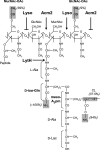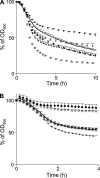Characterization of O-acetylation of N-acetylglucosamine: a novel structural variation of bacterial peptidoglycan
- PMID: 21586574
- PMCID: PMC3129176
- DOI: 10.1074/jbc.M111.241414
Characterization of O-acetylation of N-acetylglucosamine: a novel structural variation of bacterial peptidoglycan
Abstract
Peptidoglycan (PG) N-acetyl muramic acid (MurNAc) O-acetylation is widely spread in gram-positive bacteria and is generally associated with resistance against lysozyme and endogenous autolysins. We report here the presence of O-acetylation on N-acetylglucosamine (GlcNAc) in Lactobacillus plantarum PG. This modification of glycan strands was never described in bacteria. Fine structural characterization of acetylated muropeptides released from L. plantarum PG demonstrated that both MurNAc and GlcNAc are O-acetylated in this species. These two PG post-modifications rely on two dedicated O-acetyltransferase encoding genes, named oatA and oatB, respectively. By analyzing the resistance to cell wall hydrolysis of mutant strains, we showed that GlcNAc O-acetylation inhibits N-acetylglucosaminidase Acm2, the major L. plantarum autolysin. In this bacterial species, inactivation of oatA, encoding MurNAc O-acetyltransferase, resulted in marked sensitivity to lysozyme. Moreover, MurNAc over-O-acetylation was shown to activate autolysis through the putative N-acetylmuramoyl-L-alanine amidase LytH enzyme. Our data indicate that in L. plantarum, two different O-acetyltransferases play original and antagonistic roles in the modulation of the activity of endogenous autolysins.
Figures







Similar articles
-
SpxB regulates O-acetylation-dependent resistance of Lactococcus lactis peptidoglycan to hydrolysis.J Biol Chem. 2007 Jul 6;282(27):19342-54. doi: 10.1074/jbc.M611308200. Epub 2007 May 7. J Biol Chem. 2007. PMID: 17485463
-
Peptidoglycan O-acetylation is functionally related to cell wall biosynthesis and cell division in Streptococcus pneumoniae.Mol Microbiol. 2017 Dec;106(5):832-846. doi: 10.1111/mmi.13849. Epub 2017 Oct 26. Mol Microbiol. 2017. PMID: 28960579 Free PMC article.
-
Identification of key peptidoglycan hydrolases for morphogenesis, autolysis, and peptidoglycan composition of Lactobacillus plantarum WCFS1.Microb Cell Fact. 2012 Oct 15;11:137. doi: 10.1186/1475-2859-11-137. Microb Cell Fact. 2012. PMID: 23066986 Free PMC article.
-
Structural variation in the glycan strands of bacterial peptidoglycan.FEMS Microbiol Rev. 2008 Mar;32(2):287-306. doi: 10.1111/j.1574-6976.2007.00088.x. Epub 2007 Dec 5. FEMS Microbiol Rev. 2008. PMID: 18070068 Review.
-
O-Acetylated peptidoglycan: controlling the activity of bacterial autolysins and lytic enzymes of innate immune systems.Int J Biochem Cell Biol. 2011 Dec;43(12):1655-9. doi: 10.1016/j.biocel.2011.08.007. Epub 2011 Aug 24. Int J Biochem Cell Biol. 2011. PMID: 21889603 Review.
Cited by
-
O-glycosylation as a novel control mechanism of peptidoglycan hydrolase activity.J Biol Chem. 2013 Aug 2;288(31):22233-47. doi: 10.1074/jbc.M113.470716. Epub 2013 Jun 12. J Biol Chem. 2013. PMID: 23760506 Free PMC article.
-
Oxygen relieves the CO2 and acetate dependency of Lactobacillus johnsonii NCC 533.PLoS One. 2013;8(2):e57235. doi: 10.1371/journal.pone.0057235. Epub 2013 Feb 26. PLoS One. 2013. PMID: 23468944 Free PMC article.
-
Mechanistic Pathways for Peptidoglycan O-Acetylation and De-O-Acetylation.Front Microbiol. 2018 Oct 1;9:2332. doi: 10.3389/fmicb.2018.02332. eCollection 2018. Front Microbiol. 2018. PMID: 30327644 Free PMC article. Review.
-
The major autolysin Acm2 from Lactobacillus plantarum undergoes cytoplasmic O-glycosylation.J Bacteriol. 2012 Jan;194(2):325-33. doi: 10.1128/JB.06314-11. Epub 2011 Nov 11. J Bacteriol. 2012. PMID: 22081384 Free PMC article.
-
O-Glycosylation of the N-terminal region of the serine-rich adhesin Srr1 of Streptococcus agalactiae explored by mass spectrometry.Mol Cell Proteomics. 2014 Sep;13(9):2168-82. doi: 10.1074/mcp.M114.038075. Epub 2014 May 5. Mol Cell Proteomics. 2014. PMID: 24797265 Free PMC article.
References
Publication types
MeSH terms
Substances
LinkOut - more resources
Full Text Sources
Other Literature Sources
Medical
Molecular Biology Databases

